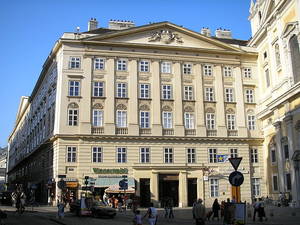Schottenstift

In 1156, due to the efforts of Henry II Jasomirgott, son of Margrave Leopold III, Ostarrichi became an independent Margraviate of Bavaria and was elevated to dukedom. (Privilegium Minus). Duke Henry II chooses Vienna to be the new residence of the Babenbergs. The foundation of a monastery gave the ruler support for his administration (for example, schools to educate competent scribes). It also provided a library, a hospice and old age home, architects, educated men, and priests to conduct services in the new ducal city. Henry II brought Irish monks to Vienna, who did not come directly from Ireland, but from an Irish monastery in Regensburg, Germany. In the early Middle Ages, Irish monks were actively involved in missionary work. Ireland was known in Latin as "Scotia Major"; therefore, in German, Irish monks were called "Schotten" (Scots) or "Iroschotten".
Between 1110 and 1200, a gigantic roman church was built at the “Freyung”, which was outside of the city walls of Vienna and was consecrated by Bishop Wolfger von Ellenbrechtskirchen. Fire (1276) and an earthquake (1348 and 1443) destroy big parts of the monastery. In 1418 the era of the „Iroschotten“ in Vienna comes to an end, because though lack of procreation of their own, they refuse to take locals, and rather withdraw. A community of Benedictines took their place. These new residents, however, continued to be known as the "Schotten".
The collapse of the tower, struck by a lightning bolt in 1638, was seized as an opportunity to completely rebuild the church. The church was somewhat shortened, and the tower no longer stood directly beside the basilica. After the Turkish siege, the church was restored. As the Baroque west tower was barely higher than the facade itself, its extension has often been proposed, but this has never come to fruition. Around 1830, the auxiliary buildings of the Abbey, in particular those that bordered on the Freyung, were renovated and partially rebuilt by Joseph Kornhäusel, who also contributed to the rebuilding of the Abbey of Klosterneuburg.
The "Schotten" were also intensively involved with the University of Vienna, founded in 1365, leading to the development of their first library. With the renovation of the monastery a new library hall was made for the printed books.
In 1807 the “Schottengymnasium”, an institute for secondary education, was founded by imperial decree. Thus education becomes the monks’ main task. Between 1938 and 1945 the school was shut down.
Abbey library of the “Schotten”
The "Schotten" were also intensively involved with the University of Vienna, which was founded in 1365, where monks taught every now and then. Soon a library developed in the Abbey.
The historically grown library now owns around 200,000 books of which 120,000 date before 1900. These consist of 442 incunables, 2,650 titles from the 16th century, 9,000 books from the 17th century, approximately 35,000 books from the 18th century, another 70,000 from the 19th century. Around 10,000 are prints up until 1914.
The manuscripts are maintained in different units of the archive.
Besides the chronological certificates, of which 800 are sealed certificates (from 1161), the main archive possesses some personnel records of the abbots, as well as documents of incorporated parishes, buildings and old possessions of the abbey.
In the economy section of the archive there are bills of different agencies, and documents of the parishes and the finances of the abbey.
In the musical archive there are more then 2,500 handwritten compositions of church music (from the beginning of the 18th century) and more than 600 printed notes.
Source:
http://www.schottenstift.at/
Image source:
commons.wikimedia.org/wiki/File:Schottenstift_Vienna_Sept._2006_001.jpg





